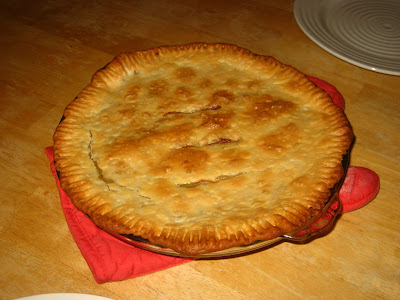I cook the way most people look at a menu. I stand in front for my fridge with both doors wide open as if I am staring at a menu. Basking in the cool air as it flows over me, never mind the electricity I am wasting, I stare in and taking a mental inventory of what I have on hand. And just like you do when reading a menu, I study the dish options and pick out what "sounds good" to eat.

As a bit of a flibbertigibbet, I am not much of a planner. I can plan the big things in life, but sometimes the little things just get left to living in the moment. I love spontaneity, thus the menu style cooking habit. I have taken this same approach to grocery shopping. I would wheel my cart down each isle tossing in whatever "sounded good" from the stores shelves. There are some definite essentials that are purchased weekly, milk, eggs, butter, bread...ect. but beyond that, I usually ransack the isle and purchase a hodgepodge of ingredients. Then these items end up spending weeks in my pantry or refrigerator before I ever get around to preparing them, if at all.
Cooking and shopping in this manner can get to be a little pricey at the groceries store and turn you homes pantry and refrigerator into what resembles a mini grocery store. While in theory this would be great to have any ingredient you want readily available, in today's times, it just isn’t practical. We are all living on a budget and the thought of chucking spoiled food out in the trash or having a pantry item sitting on the shelf for months and months, is just like throwing good hard earned money away. That food would be better used at a local food bank or shelter instead of gathering dust or feeding the critters at the local dump.
So how do we take control of our food budgets and keep our kitchens properly stocked? Yep .. you guessed it ... Planning. (groan) But hear me out for a minute. Once you get your pantry and refrigerator stocked with the basic essentials and plan your weekly dinner choices, your trips to the grocery store will be much more productive and your panty won’t look like a small market. Not to mention your food budget will be reined in. If saving money and the recovered real estate in the pantry doesn't entice you into a little planning ahead, how about being able to eat premium cuts of meats and specialty ingredients. If you haven't blown your food budget on 20 different cans of soup that will take up residence in your pantry you can afford the nice plump shrimp or a marbled rib eye steak. With a little planning you can start to explore the pages of your cookbooks and plan to try something new.
Enter the Weekly Menu (with a bit of a twist)
In an effort to change my ways and still retain some of my spontaneity, I intend to embrace the Weekly menu method and invite you to join me. Here is the rub, plan a week’s worth of meals plus one pitch hitter. Each night you choose something off the list rather than assigning it to a specific day. Why the 8th extra meal? So that on the last day of the week you still have a choice of what to make for dinner. Go thru you cookbooks and food magazines to pick out 2 or 3 new recipes to try and throw in a couple of the old standbys the family enjoys.
Now that the menu is created, your next step is to create a shopping list. On the list is the additional ingredients needed to accomplish the 8 recipes along with any missing pantry/fridge essentials that need to be replenished. Below is my list of Essentials. It is a good place to start to stock your pantry. Just make sure your list does not have any specialty items on it, save those to be purchased on the week you intend to use them. I usually end the week with my trip to the grocery store so I can start the weekend with a kitchen full of fresh ingredients.
Pantry Essentials.
Flour
Sugar - Powder, Brown and White
Baking mix - Bisquick and Plain Muffin Mix
Cornmeal
Bread Crumbs - Plain and Panko
Stock - Chicken and Beef
Tomato Paste
Can Diced Tomatoes
Can Beans - Ranch, Pinto, Black,
Cooking Wine - Red and White (I use a good box wine for this as it is air tight and keeps longer)
Pasta - Spaghetti, Penne, Couscous, and Chow Mein Noodles
Rice- Basmati, Jasmine, Pilaf blend,
Oil - Veggie and Extra Virgin Olive Oil
Vinegar - Balsamic, White and Apple Cider
Bread
Quick Oats
Cereals
Coffee
Peanut Butter
Potatoes
Spice Cabinet Essentials
Pumpkin Pie Spice
Nutmeg
Cinnamon
Ground Ginger
Paprika
Cocoa
Corn Starch
Baking Powder and Soda
Sea Salt
Pepper - Black and White
Steak Seasoning Blend
Taco Seasoning Blend
Italian Seasoning Blend
Vanilla - Extract and Whole Beans
Fridge Essentials
Milk - 1%, Heavy Cream, Half/Half, Coffee Creamer
Sour Cream
Yogurt - Vanilla and other flavors
Butter
Eggs
Cheese - Parm. Mexican Blend, Cheddar
Jelly/Jam - Grape and Orange Marmalade
Maple Syrup
Salsa
Ketchup
Mustard - Yellow and Dijon
Chili Sauce
Sweet Chili Sauce
Hoisin
Soy Sauce
Worcestshire Sauce
Salad Dressing - Ranch and Vinaigrette
Bag Salad
Tomatoes
Carrots
Onions - Chives, Green Onion, Sweet
Lemon/Limes - Juice or Fresh
Frozen Veggies





























